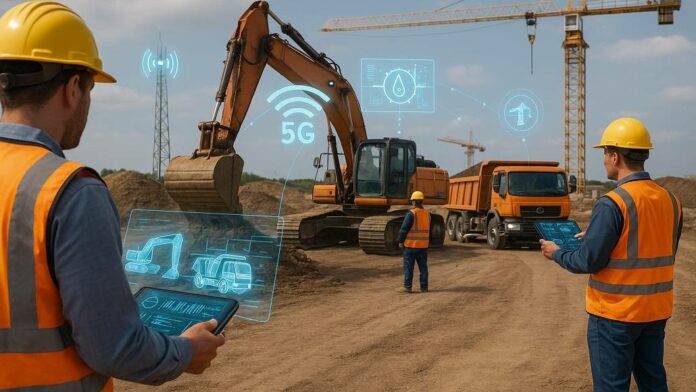The construction industry is poised for a technological revolution, and 5G connectivity is at the helm of this transformation. One of the most promising developments of the day, 5G technology is not just about speeding up internet speeds; it is empowering the construction industry to rethink processes, improve operational efficiency, and facilitate worker safety on an unprecedented scale.
The remarkable applications of 5G technology have transformed construction fleet operations into a revolutionary force in the industry. The construction sector now experiences a revolution in its fleet management due to 5G technology which enables immediate synchronization and simple communication alongside new safety systems.
Construction fleets serve as the fundamental project engines that transport materials equipment and personnel throughout complex work sites. Fleet management has faced numerous challenges since modern construction began—everything from unexpected delays to inefficient routing and safety risks have been persistent issues for years. With the introduction of 5G technology, we can address these difficulties with unprecedented precision and efficiency.
Revolutionising Fleet Management with 5G
The introduction of 5G-enabled construction fleets will transform how we manage and coordinate operations. Unlike earlier communication technologies, 5G provides ultra-low latency, increased network dependability, and extremely rapid data transfer speeds. This allows fleets to share information in real time, resulting in a smooth flow of data between vehicles, operators, and command centres. One of the most amazing features of 5G is its ability to quickly synchronise fleets. In the construction business, where materials and machinery must be moved on tight deadlines, there is little space for error. Fleet managers may use 5G to track vehicle positions, fuel usage, and delivery timelines down to the minute.
Furthermore, 5G’s capacity to connect a huge number of devices allows entire fleets to be outfitted with IoT sensors and communication modules. These gadgets constantly collect and transmit information concerning vehicle performance, weather, and cargo status. This rich trove of data enables fleet managers to make informed decisions, avoid wasteful delays, and reduce vehicle wear.
The Role of 5G in Enhancing Safety
Safety is a top responsibility in construction, and 5G is changing the way we handle fleet safety. Construction vehicle accidents not only cause expensive delays but also endanger workers and the public. With 5G allowing for sophisticated safety features, construction fleets are able to operate with the best possible standards of safety and accountability.
Networked vehicles with 5G capabilities are capable of communicating with each other in real-time, so that every vehicle knows what is around it. This feature comes very handy in congested job sites, where blind spots and poor visibility are inevitable risks. Vehicles can steer clear of accidents and work in sync with site conditions by exchanging information on positions, velocity, and paths.
5G-powered driver monitoring systems provide an additional layer of protection through real-time analysis of driver behavior.
Internal vehicle cameras and sensors can identify fatigue signs, distraction, or unsafe driving habits.Both the driver and the fleet manager get instant alerts, allowing them to take proactive steps before accidents occur. Additionally, with 5G technology, we can introduce autonomous or semi-autonomous systems into construction fleets. These autonomous trucks, equipped with 5G connectivity, can follow set routes with impressive precision, significantly reducing the chances of human error.
Table: Key Benefits of 5G-Enabled Fleet Safety
| Safety Feature | Impact on Fleet Operations |
| Real-Time Vehicle Communication | Prevents collisions and improves coordination in crowded worksites. |
| Driver Monitoring Systems | Detects unsafe behavior to minimize accident risks. |
| Autonomous Vehicle Integration | Reduces human error and enhances operational precision. |
Boosting Efficiency Through Predictive Analytics
5G technology is used for predictive analytics, helping fleet managers to improve efficiencies and cut costs. Have IoT sensors installed in each vehicle so that they collect huge amounts of data about various performance parameters like engine health, tire pressure, fuel consumption, etc.; this data is then transferred over 5G networks into cloud-based platforms where advanced algorithms analyze the data for pattern recognition and assess the likelihood of those problems manifesting in the future.
5G predictive maintenance makes it possible for fleet managers to detect and correct mechanical issues before they cause expensive breakdowns.
For instance, sensors can identify subtle signs of wear and tear on vital parts and automatically send alerts for scheduling maintenance. This anticipatory approach reduces downtime for vehicles, saves on repair costs, and extends the life of fleet assets. In addition, 5G-driven analytics optimize fleet routes and scheduling.
Building a Resilient Fleet Ecosystem
Adoption of 5G in construction fleet applications is more than just a tech upgrade; it is about creating a powerful and future-proof fleet ecosystem. By casting the net of real-time communication, greater safety measures, and predictive analytics, construction companies can nurture their business and stay ahead in a market shaped by rapid changes.
Stakeholder engagement will be crucial in unleashing the full power of 5G-enabled fleets. The technology providers, equipment manufacturers, and construction companies must work closely to create integrated solutions that address the specific needs of construction. Standards for interoperation shall also become relevant to blend 5G technology nicely across fleet types.
Training on 5G-enabled technology will be equally important. Managers and fleet operators will have to learn to read data through insight and apply 5G technologies to its fullest. Training programs and certifications can help bridge the gap between technological advancements and their real-world applications.
Future Trends in 5G-Enabled Construction Fleets
The future of construction fleets powered by 5G is filled with exciting possibilities that are poised to transform the industry. One notable trend is the integration of edge computing, where data is processed closer to its source instead of in centralized data centers. This approach enhances the responsiveness of fleet management systems by enabling quicker analytics and decision-making.
Another emerging trend is the use of digital twins—virtual replicas of physical assets that mirror real-world conditions. Fleet managers can utilize 5G-enabled digital twins to experiment with various scenarios, optimize operations, and predict outcomes with unprecedented accuracy. Governments and industry actors are likely to propose incentives and legal frameworks that facilitate the use of 5G technology in building, hence fuelling innovation and uptake.
Conclusion
5G-enabled construction fleets are a significant step forward in the evolution of fleet management. 5G is revolutionising how fleets work on construction sites by combining ultra-fast connectivity, real-time synchronisation, and sophisticated safety measures. The capacity to track, analyse, and optimise fleet performance in real time not only increases efficiency, but also raises the standard for safety and reliability.
With 5G at the forefront, the construction industry is on track to achieve its goal of creating smarter, safer, and more sustainable projects. By fostering collaboration, driving innovation, and investing in workforce development, 5G-enabled fleets are ready to reshape the future of construction, leaving a lasting mark on industry practices and results. Thanks to 5G, the construction sector is stepping into a new era of connected and efficient operations, paving the way for a brighter future for everyone involved.
































